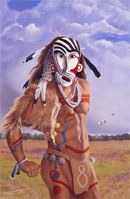The Key Marco Cat – a half-human, half-panther
figure thought to have religious significance – is the
most famous of the Pepper-Hearst artifacts. Carved in native
buttonwood using shark teeth and shell
scrapers,
the 6-inch figure is a pristine example of the fine Calusa
artistry and workmanship. Cushing himself described it
as a:
“...man-like being in the guise
of a panther. Although it is barely 6 inches in height,
its dignity of pose may fairly be termed “heroic”, and
its conventional lines are to the last degree masterly.
While the head and features – ears, eyes, nostrils and
mouth – are most realistically treated, it is observable
that not only the legs and feet, but also even the paws,
which rest so stoutly upon the thighs or knees of the
sitting or squatting figure, are cut off, unfinished;
bereft, as it were, of their talons. And this, I would
note, is quite in accordance with the spirit of primitive
sacerdotal art generally – in which it was ever sought
to fashion the form of a God or Powerful Being in such
wise that while its aspect or spirit might be startlingly
shown forth, the powers associated with its living form
might be so far curtailed, by the incompletion of some
of its more harmful or destructive members, as to render
its use for the ceremonial incarnation of the God at
times, safe, no matter what his mood might chance, at
such times, to be.” **
Scientists say that careful rubbing with animal fat left
a patina that protected the figure after it was buried by
a catastrophic hurricane in the 12th or 13th century.
Although more than 100 wooden ceremonial masks,
statuettes, batons, and heads of animals such as a wolf,
sea turtle, pelican, and alligator were found, the article
that most fascinated Cushing was a wooden deer head.
He wrote:
"This represents the finest
and most perfectly preserved example of combined carving
and painting that we found .... In form ... it portrayed
with startling fidelity and delicacy, the head of a young
deer or doe .... [The ears] were also relatively large ...
fluted, and their tips were curved as in nature ... they
were painted inside with a creamy pink-white pigment ...
and the black hair tufts at the back were neatly represented
by short black strokes of paint .... The muzzle, nostrils
and especially the exquisitely modeled and painted lower
jaw, were so delicately idealized that it was evident the
primitive artist who fashioned this masterpiece loved, with
both ardor and reverence, the animal he was portraying...."

In 2006, Naples resident gained
unprecedented access to unpublished photos*
of the Key Marco Cat (now housed at the Smithsonian Institution
National Museum of Natural History). Using those photos and
archeological records, Peter carved an accurate replica
of the cat from which to create a mold and castings, and
developed a proprietary paint-stain combination that closely
approximates the original patina.
*Photographs provided by Bill
Perdichizzi, a director of the Marco Island Historical
Society. Bill and his wife Betsy were granted special
access to the Key Marco Cat by Smithsonian Institute
archivists.
**Frank Hamilton Cushing, 1896.
Proc. Amer. Phil. Soc., Vol.XXXV, No. 153, Pepper-Hearst
Expedition. A Preliminary Report on the Exploration of
Ancient Key-Dweller Remains on the Gulf Coast of Florida.
*** "Sacred Rain" image
at top of page used with the permission of Florida artist Theodore
Morris. See more of his work at .

